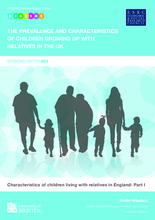This briefing paper series provides snapshots from the research titled ‘Kinship Care Re-visited: Using Census 2011 Microdata to Examine the Extent and Nature of Kinship Care in the UK’ funded by the Economic and Social Research Council (ESRC) grant ES/K008587/1. This work contains statistical data from the Office for National Statistics (ONS), which is Crown Copyright. The use of ONS statistical data in this work does not imply the endorsement of the ONS in relation to the interpretation or analysis of the statistical data. This work uses research datasets which may not exactly reproduce ONS aggregates.
Other briefing papers in the series include:
- Briefing Paper 002: Characteristics of children living with relatives in Wales
- Briefing Paper 003: Characteristics of children living with relatives in Scotland
Key Messages:
- This briefing paper is the first in a series, from an Economic and Social Research Council (ESRC) funded research study. The study explores the prevalence and characteristics of children growing up in kinship care in the UK using 2011 Census microdata (grant ES/K008587/1).
- This paper explores the main characteristics of children growing up in kinship care in England.
- Kinship care remains the most prevalent form of non-parental care for children who are unable to live with their parents in England.
- At the time of the 2011 Census, there were just over 11.3 million children (0-18years) living in England. Of these, an estimated 152,910 (1.4%) children were living in kinship care.
- In other words, in 2011, one in 74 children in England were growing up in the care of relatives.
- Since the last Census in 2001, the kinship child population had grown at a rate of 7%, resulting in 9,543 more children in kinship care in 2011.
- The 7% growth in the kinship child population is more than three times that of the population growth rate of all children in England, which was 2% over the same time period.
- The highest regional prevalence of kinship care (1.7%) was seen in Greater London and the North East.
- The highest regional growth rates in the kinship child populations between 2001 and 2011 were seen in the South West (40%) and the South East (24%) regions.
- Nearly one in three (32%) children growing up in kinship care in England were non-white. In the population of children growing up with at least one parent, 24% were non-white.
- The highest prevalence of kinship care was seen within the black ethnic group. One in every 37 black children was growing up in the care of relatives.
- Despite kinship care still being the predominant option for children who are unable to live with their parents in England and despite research evidence that children living in kinship care have better outcomes than children fostered by non-relatives, the results of this study show that a large number of children in kinship care are affected by poverty and deprivation.
- Forty percent of all children in kinship care in England were living in households located in the 20% of the poorest areas in England. This is an improvement of only 4% since 2001, which implies that the financial burden on kinship families still remain an area of concern.
- More than three quarters (76%) of the kinship children were living in a deprived household. The high prevalence (4%) of kinship children in the most deprived households in England and the low prevalence (0.7%) of kinship children in the households with no deprivation indicate a pressing need for support and services to be provided to these children and their kinship families.
- One in two (51%) children were growing up in households headed by grandparents whilst 23% were growing up in households headed by a sibling. The remaining were growing up in households headed by another relative, such as an aunt, an uncle or a cousin.
- Compared with children growing up with at least one parent, children in kinship care were nearly twice as likely to have a long-term health problem or disability that limited their day-to-day activities.

